Abstract
Feed efciency is more and more important for all kinds of animal production. Increased feed costs, the awareness of limited raw material resources and environmental issues are driving factors. Therefore individual feed intake of animals is measured and influenced in selection programs. In the past individual feed intake of meat type poultry has been recorded in single cage systems. Those systems are unfavourable for the heavier types of birds, especially the Pekin ducks and don’t represent practical housing conditions. The utilisation of sophisticated RFID technologies enables the breeding companies nowadays to record even small meals of individuals under nearly practical conditions. In these testing units not only the amount of feed consumed can be recorded, it opens also the possibility to detect the feeding behaviour.
Keywords
Feed efciency, Feeding Behaviour, Pekin duck, Genetic parameters
Introduction
Feed efciency has become more and more important for all kinds of animal production, in response to rising feed cost and awareness of limited resources and environmental issues. Therefore, individual feed intake of the birds is measured and used in selection programs. In the past, individual feed intake of ducks has been recorded in single cage systems (Wolf, 1983; Klemm, 1985; Tieu H. van, 1986; Reiter, 1990; Klemm and Pingel, 1992; Klemm, Reiter and Pingel, 1994; Thiele, 1995), but this system is unfavourable for the ducks and may not reflect feeding behaviour under commercial floor conditions. The limited space in cages reduces locomotion of the birds and induces leg problems and mortalities, especially in heavy male lines. Even specially equipped single floor pens (Kain, 1989) with sufcient space miss the social elements of large flocks and don’t represent the ideal environment for testing the feed efciency of individual birds. Using novel RFID technology, breeding companies are today able to record even small meals of individuals under nearly practical housing conditions. In these testing units not only the amount of feed consumed can be recorded, it opens the possibility to observe also the feeding behaviour of the ducks, in terms of frequency of meals and size of a single meal (Bley, 2003; Bley and Bessei 2008; Howie et al. 2009; Howie et al. 2010; Basso et al., 2014; Alletru and Thiele, 2016; Le Mignon, Blanchet and Chapuis, 2017). The availability and utilisation of these feeding stations accelerates the genetic progress in feed efciency. Records of daily feed intake can be used to improve feed efciency in combination with the weight gain during the testing period as the commonly known FCR or, independent from metabolic body weight and weight gain, as residual feed intake (RFI) (Aggrey et al., 2010; Herd and Arthur, 2009). Beside commonly known growth parameters, differences in the behaviour of single birds can be measured and analysed. This opens the possibility to select also on feeding behaviour to accelerate progress in feed efciency or to maintain the natural feeding behaviour of the species. Maintaining the natural behaviour of domesticated animals is becoming more and more important in Western societies where ethical production of meat and wellbeing of animals is important to consumers. Recent examples are discussions about “exploding chicks” in the Dutch broiler industry and the “flip over syndrome” in the German duck industry.The aim of this study was to evaluate the records of performance and behaviour traits of Pekin ducks measured in a feeding station, using a radio frequency identifcation system and to estimate genetic parameters of those traits.
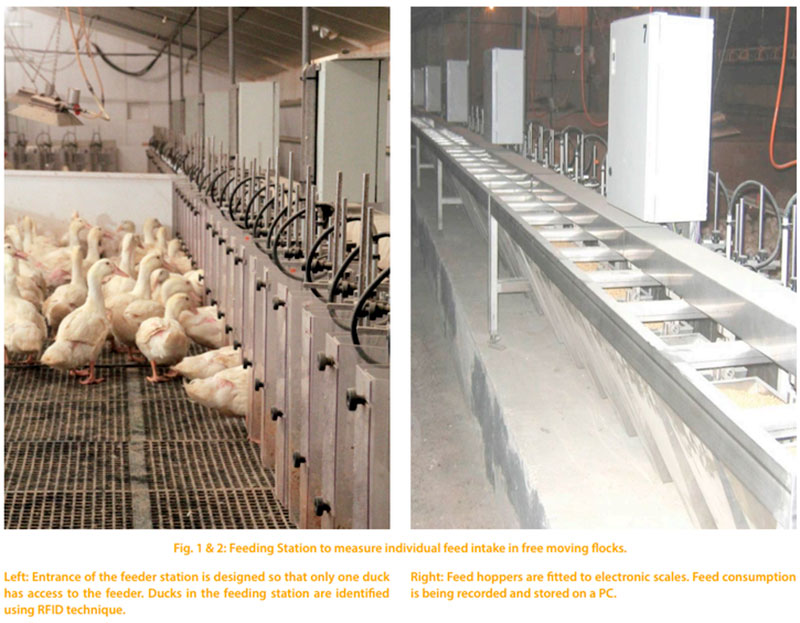
Material and Methods
Feeding Station and Animals: The feeding station is equipped with individual feeding places where only one duck can eat at the same time. Access to the entrance of the feeder is restricted on both sides by a transparent plastic wall, which can be adjusted to the needs of growing birds. A barrier has been added between the plastic walls to prevent other ducks from climbing over the companions while they are feeding. The single feeder places are designed to accommodate a weighing cell, located above the feed hopper. The accuracy of the weighing cell is about 0.2 g, which allows the measurement of even small meals of young ducklings. An antenna is mounted in front of one of the sidewalls of each feeder place. Eight antennas represent one module, which is controlled by a multiplexed RFID reader system. Each duck is marked with a wing band containing a HDX transponder with a unique ID. Above the entrance of each single feeder place a photoelectric sensor is mounted to control the presence of a duck.When a duck is entering the feeding station and the sensor detects a movement, the weighing cell is set to TARA. After a duck leaves the feeder place, the sensor gives a signal to the system to record the amount of feed consumed as measured by the weighing cell, the feeder place, the date and time of entrance and exit into the unit and the transponder ID of the bird. All this information is transferred to a data base located on the PC running the recording software. Our study is based on a sample of a much larger set of data, recorded in recent years. The sample represents 4630 Pekin duck males of two ORVIA pure lines, from four hatches in two years, which were tested for feed intake parameters and feeding behaviour traits during 28 days, from 14 to 42 days of age. The stocking density was 7.0 to 7.3 birds/m2 floor surface, 5.4 to 5.7 birds per nipple drinker, and 17.8 to 19.4 birds per single feeder place, with 16 hours light per day. The birds were fed ad libitum with pelleted commercial duck starter and grower feed, which was sieved to reduce the amount of mesh before supplied to the feeders. The drinkers were placed at a distance of 2-3 meters from the feeders and accessible ad libitum.
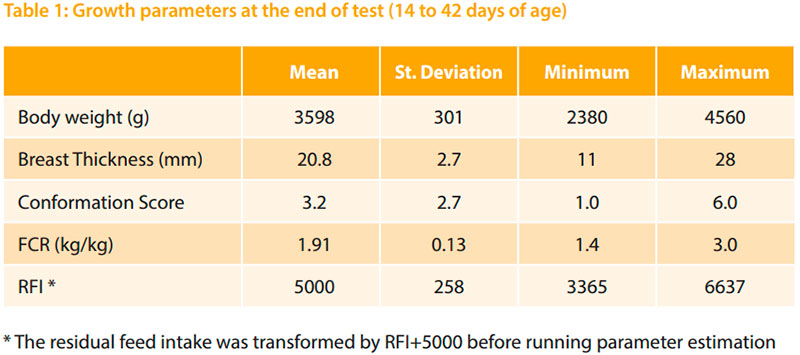
Traits and Analysis
Before estimating genetic parameters, the source data were screened for outliers, and questionable records were excluded, e.g. from birds resting in the station, records with undetected identities, extremely low total feed intake over the 28 day testing period and other identifed outliers. Records for all traits were tested for normality before further analysis.Feed intake and body weights were measured at 14 and 42 days, at the beginning and end of the test, in addition the breast thick ness at 42 days. From these source records, feed efciency was calculated in terms of feed conversion ratio (FCR = kg feed intake/weight gain) and residual feed intake (RFI) was calculated as described below.
Residual Feed Intake RFI=FI–[a+b1* BW0.75 + b2*BW G] FI = Feed intake BW = Body weight BWG = Body weight gain
The residual feed intake was transformed to RFI+5000 before running the parameter estimation.
The feeding behaviour parameters recorded are the number of meals per day (TSUM), the average meal duration (TIME), the feeding rate as consumed feed per minute (RATE), the average daily feed intake (ADF) and the duration of feed intake per day (FDUR).

Our analysis confrmed the fndings of Howie et al. (2010) that the number of visits can be used to characterise a meal in Pekin ducks, provided accurate and continuous bird identifcation is guaranteed.
The parameter estimation was performed with the REML package VCE 6.0 (Groeneveld, 2010).
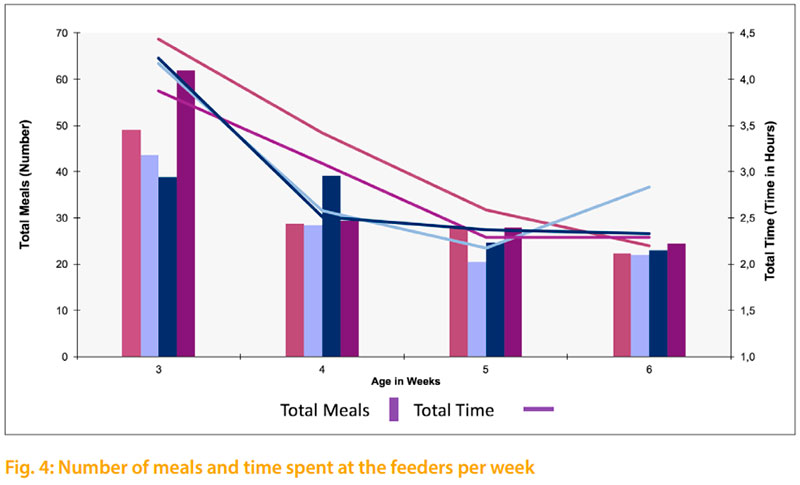
Multi trait animal model: Y = X β + Z u + e
Where: Y is a vector of observations (performance and behavior traits), β, u and e are the vectors of fixed, random and random residual effects respectively, and X and Z are known incidence matrices. The line, the generation and the time box (time period for tested animal) have been set as fixed effects.
Results and Discussion
As shown in Table 1, the level of growth performance and feed efciency in both male lines and a sufcient phenotypic variation in those performance traits representing the genetic potential of the lines and have not been depressed by the testing environment.Moderate to high heritability’s and genetic correlations among the performance traits indicate sufcient scope for further improvement of those traits (Table 3). Selecting on RFI, i.e. eliminating the influence of body weight, is more promising than selection on FCR, especially when body weights should not be increased. A positive (unfavourable) genetic correlation between feed efciency and breast thickness or conformation score was found. When ducks develop their flying abilities and gain breast meat yield, the development of abdominal fat reserves takes place parallel. When selecting on feed efciency it is necessary to keep an eye on breast meat evelopment to maintain good meatiness.
During the testing period, with increasing daily gain of the Pekin duck males, their feed intake increased. When growing and developing their feeding capacities, the number of meals and the duration per meal decreased. Due to their limited feeding capacities in early life, the feeding activities of the ducks are much higher in the frst weeks compared to the end of the testing period.
The feeding behaviour parameters of the complete testing period confrm the results of Bley (2003), Bley and Bessei (2008) and Le Mignon, Blanchet and Chapuis (2017). The difference in the recorded feed intake per minute (RATE) might be linked to the higher stocking density in the ORVIA testing station. There is considerable variation in the behaviour of different birds. The fndings of this study agree well with the results of the other authors, but the heritability’s of the behaviour traits are higher than expected.
There is nearly no genetic correlation between the number of meals (TSUM), the feeding rate (RATE) and the residual feed intake (RFI). The average meal duration (TIME), the duration of the feed intake per day (FDUR) and the average daily feed intake (ADF) have moderate and relatively high positive genetic correlations with residual feed intake (RFI). Looking at the genetic correlations of these behaviour traits with FCR, a slightly negative effect of high feeding activities and feed efciency is obvious. This has to be kept in mind to avoid a negative effect on the ducks’ behaviour, when selecting on feed efciency.
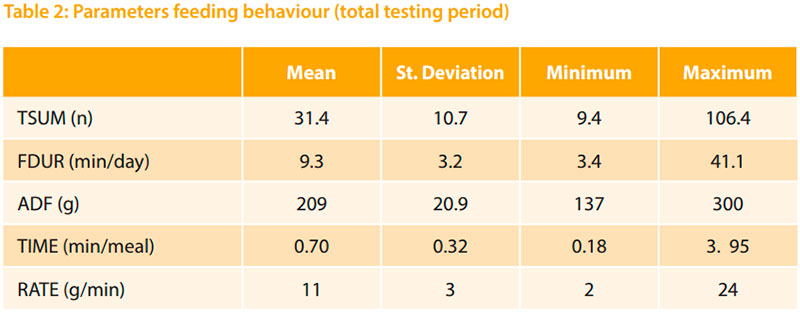
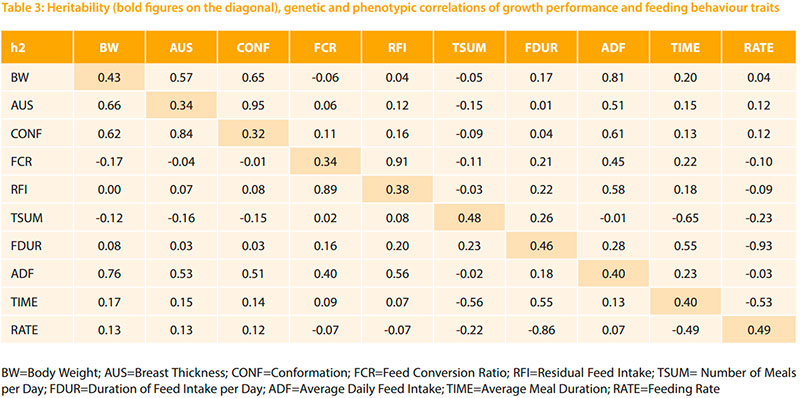
It has been shown that lines differ in their behaviour traits (Alletru and Thiele, 2016), and differences between lines in the correlations among feed efciency and behaviour traits have been found in the ORVIA data pool.
Summary
The modern RFID technology enables the breeding companies nowadays to record even small meals of individuals under nearly practical housing conditions. In these testing units not only the amount of feed consumed can be recorded, it opens the possibility to observe also the feeding behaviour of the ducks, with the frequency of meals and the size of a single meal. The availability and utilisation of these feeding stations accelerates the genetic progress in feed efciency. Records of daily feed intake can be used to improve feed efciency in combination with weight gain during the testing period as the commonly known FCR or, independent from metabolic body weight and weight gain, as Residual Feed Intake (RFI). Feeding behaviour traits can give an input to fne-tune feed selection. They can be used either to support the selection on feed efciency or to maintain the natural feeding behaviour of Pekin ducks, when selecting on feed efciency.

Acknowledgement
The author is working for the company GOURMAUD SELECTION (Group ORVIA) since 2002 as a consultant geneticist. Pictures to illustrate data collection were kindly contributed by the Group ORVIA.Literature
Aggrey S.E., A.S. Karnuah, S. Bram and N.B. Anthony (2010) Genetic properties of feed efciency parameters in meat-type chickens. Genetics Selection Evolution 42:25-29.Alletru, B. and H.-H. Thiele (2016) Selection for Feed Efciency in Ducks.
Proceedings XXV World’s Poultry Congress, Beijing, 281.
Basso, B., M. Lagüe, G. Guy, E. Ricard and C. Marie-Etancelin (2014) Detailed analysis of the individual feeding behavior of male and female mule ducks. J. Anim. Sci. 92: 1639-1646.
Bley, T.A.G. (2003) Untersuchungen zur Variation und Rhythmik der individuellen Futteraufnahme bei Pekingenten in Gruppenhaltung. Ph.D. Thesis, University of Stuttgart-Hohenheim.
Bley, T.A.G. and W. Bessei (2008) Recording of individual feed intake and feeding behaviour of Pekin Ducks kept in Groups. Poultry Science 87: 215.221.
Herd, R.M. and P.F. Arthur (2008) Physiological basis for residual feed intake. Journal of Animal Science 87: 64-71.
Howie, J.A., B.J. Tolkamp, S. Avendano and I. Kyriazakis (2009) The structure of feeding behavior in commercial broiler lines selected for different growth rates. Poultry Science 88:1143–1150.
Howie, J.A., B.J. Tolkamp, T. Bley and I. Kyriazakis (2010) Short-term feeding behaviour has a similar structure in broilers, turkeys and ducks. British Poultry Science 51, 714-724.
Kain, H.H., (1989) Untersuchungen zur Wirkung der Selektion auf Lebendmasse, Fleischansatz und Futteraufwand in einer produktionswirksamen Vaterlinie der Amerikanischen Pekingente. Ph.D. Thesis, University of Leipzig.
Klemm, R., (1985) Ergebnisse und Auswirkungen einer direkten Selektion auf individuellen Futteraufwand bei Enten. Ph.D. Thesis, University of Leipzig.
Klemm R. and H. Pingel (1992) Results and effects of direct selection for feed efciency in the domestic ducks: 1. Report: Results of direct selection experiments. Arch. Geflügelkunde 56: 216-221.
Klemm, R., K. Reiter and H. Pingel (1994) Results and effects of direct selection for feed efciency in the domestic ducks: 2. Methodical aspects. Arch. Geflügelkunde 58: 176-181.
Le Mignon G., M. Blancher and H. Chapuis (2017) Genetic Parameters of Electronically Recorded Feeding Behavior Traits in Meat Pekin Ducks. Proceedings 10th European Symposium on Poultry Genetics, St. Malo.
Reiter, K. (1990) Untersuchungen zum Futteraufnahmeverhalten bei Pekingenten (Anas platyrhynchos f. domestica). Ph.D. Thesis, University of Leipzig.
Thiele, H.-H. (1995) Recent tendencies in Duck Breeding, Proceedings 10th European Symposium on Waterfowl, Halle: 421-428.
Tieu, H. van (1986) Untersuchungen zur Wirkung der Selektion auf niedrigen Futteraufwand bei Enten einer schweren Linie. Ph.D. Thesis, University of Leipzig.
Wolf, A. (1983), Untersuchungen zur direkten Selektion auf individuellen Futteraufwand bei Enten. Ph.D. Thesis, University of Leipzig.










